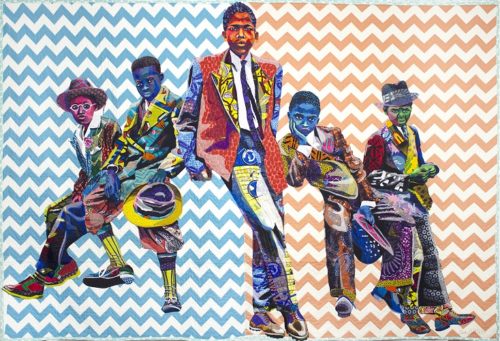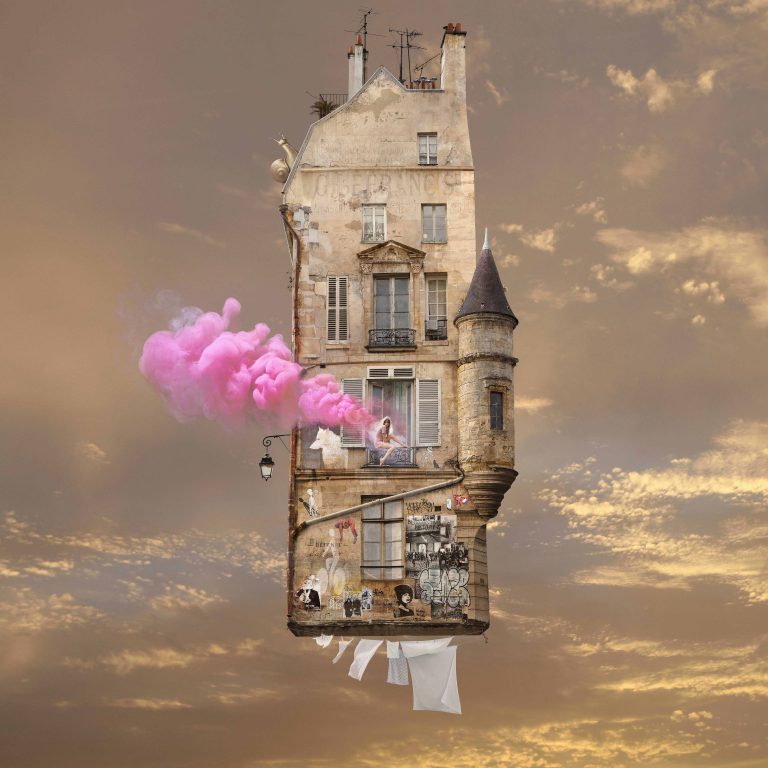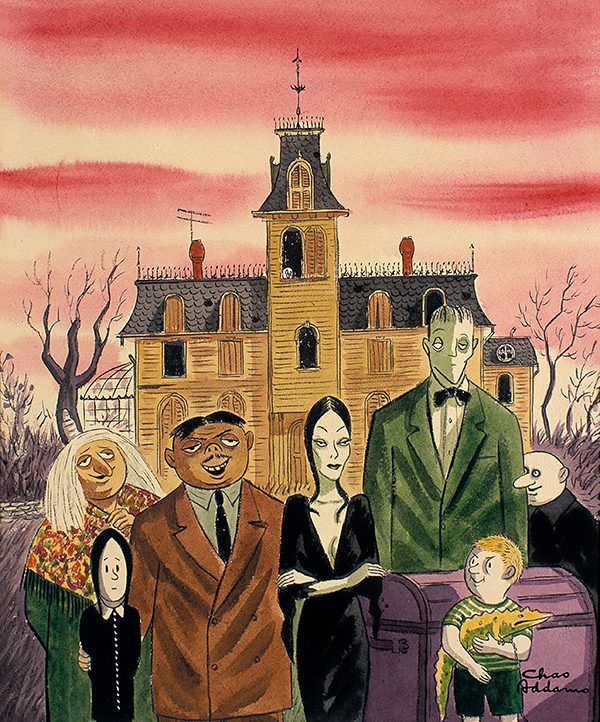The Delicate Balancing Acts of Bisa Butler and Derrick Adams

by Randy Williams,
Art Department Chair at Manhattanville College
The balancing act for contemporary artists is complicated; they must be relevant to the narrative of art history while embracing the themes of current trends. This challenge is compounded by an inescapable need for the artist to promote their self-interest in a global time warp. The consistency of change for the artists is as regular as a heartbeat, to create something new and innovative needs to be a byproduct of intense observation, disciplined and deliberate self-examination. Artists that jockey for inclusion in the mainstream of art have an additional responsibility to consider. They carry the burden of telling their personal stories with high expectations of bridging multiple worlds; they look to examine their ethnicity and simultaneous connections to the mainstream of American history and culture.
Derrick Adams and Bisa Butler have both navigated their particular and universal environments with insightfulness and clarity. In their aesthetic practices, they have masterfully made artwork that speaks to their provincial and universal viewers. Adams and Butler are two artists who personify the words of Walt Whitman: “That you are here— that life exists, and identity; That the powerful play goes on, and you will contribute a verse.”
These two artists have contributed significantly to the list of artists who work to elevate the human figure; they have done so in a distinctive manner. Both artists have a firm understanding of the human body; they know how to integrate the body into a pictorial environment. They both excel at placing human figures in uncompromising compositions. They challenge their viewers to slow down while experiencing their visual worlds. They both create compelling questions that require multiple answers. Adams’s backgrounds are often minimal and simplistic, with dynamic visual arrangements. Adams uses selective patterns, accenting parts of the human form. His backgrounds can be atmospheric, often complementing his at-rest figures. Butler is remarkable in that she can execute work in sophisticated surroundings; her intricate surface designs enhance the complexities of her figures while managing not to compete with the patterns that adorn her figures’ sometimes elaborate clothing.
Derrick Adams and Bisa Butler’s artwork is soulful; the quality of their work is arrived at through experiences connected to their respective communities. Their work is pedestrian and local. Their work is a transformation of ordinary experiences into exceptional ones. The permanence on everyday moments is fixed in time, and within the work of both artists, we can empathize with their narratives. We should be grateful for an opportunity to have multiple viewings of both artists; their work should be deliberate on overtime. If we wish to be hardy viewers, we may be rewarded with the status collaboration of the artists and not a meager observer.

Both artists approach their work with the integrity of a social scientist, like Jacob Lawrence (1917-2000). Adams and Butler approach their research meticulously. When viewing their artwork, I am reminded of Lawrence’s The Great Migration (1940-41), chronicling the Depression era flight of African Americans from the south to the north. When I view Bisa Butler’s intricate and colorful quilts, and I am also reminded of Lawrence’s magical simplicity of color manipulation. And while viewing Derrick Adam’s lounging figures, I have seen similarities with Lawrence’s authentic approach to painting ordinary people in unique ways.
Bisa Butler has expanded the vernacular quilting as a fine art form. The technique of binding and stitching cloth has been around for several millennia. She, like Sonia Delaunay (1885- 1979), uses textiles as design and stage design. And Robert Rauschenberg (1925-2008) used the quilt as a surface to apply narratives. Like Faith Ringgold (1930), she uses the quilt as a metaphor for loved experience and storytelling.
Butler has used a variety of photo techniques in her work; she has used photographs with sophistication, like Dawoud Bey (1953), and James Van Der Zee (1886-1983). Bisa Butler, like both of these photographers, selects her subjects with a quintessential decisive moment in mind. Her color and composition are exciting; her figures collaborate with the narrative to secure a visual balance that makes the viewing of her quilts effortless. What I find compelling about Butler’s work is that it is comfortable and familiar. The selection of the right images is in and of themselves a work of art; her use of African textiles with traditional design and patterns creates a cultural fusion that helps to blend a cultural aesthetic with global inferences. These inferences help to ensure that the universal language of color, composition and design speak in a collective voice even at the expense of telling individual and personal stories. Like Faith Ringgold, the origin of Bisa Butler’s work is highly personal. Quilting makes out of existing materials a trans- configuration; Butler’s artistic process seems therapeutic, and like many artists, her works help her to define her place in the world.
Derrick Adams is a shapeshifter, his work is in a state of triumphant alteration, moving from a simple image to a slightly more complex image. His minimal work is executed with a simplistic sophistication that is reminiscent of Alex Katz (1927), Will Barnet (1911-2012) and Milton Avery (1885-1965). Adams’s Floaters series, on view at Hudson River Museum beginning March 7, illustrates leisure. His more complex work is reminiscent of works by Romare Bearden (1911- 1988), Benny Andrews (1930-2006), and Faith Ringgold (1930). His painted faces, in particular, are constructed like the faces of a Romare Bearden collage. The multi-colored faces in the Floaters series seem to suggest the physical and genetic variations on African Americans. These works also suggest the notion of rational acts of inclusion; his “floaters” are relaxing; they seem to be in pursuit of the great American leisure; his work illustrates an aspiration for people that moves across all races and economic statuses.

Derrick Adams’ colors challenge the viewer in the same fashion that AfriCobra did in the 70s. AfriCobra referred to their colors as Kool-Aid colors. Adams’s colors are certainly cool; they are bright, dramatic and electric. His colors stimulate the optic nerves in the eye, creating a visual and physical sensation. The heightened senses help the viewer to activate personal memories, and these memories help to forge a personal connection to his work. I see a flickering relationship between pool paintings of Derrick Adams and David Hockney (1937). Hockney’s series of pool paintings combined action and leisure while Adams’s combine action and posing. Both artists explore the subtleties of conscious environments that clarify their figures in familiar places.

It is an exciting and rewarding time for the arts in Westchester. With Derrick Adams: Buoyant on view at the Hudson River Museum (March 7-June 17) and Bisa Butler: Portraits at the Katonah Museum of Art (on view March 15-June 14), there are ample opportunities to experience two artists with an African-American perspective on the creative process and product. James Baldwin’s often quoted words are prophetic: “I am what time, circumstance, history, have made of me, certainly, but I am also, much more than that. So are we all.”
Both of these artists have made beautiful art out of ideas, concepts and simple materials. These two artists are contemporary alchemists, making flesh out of memories, as they transform materials into poetic reckonings.
Art is greater than the total of its creator and creation. With both artists, we are asked to fill in what appears to be omitted. We give voice to the silent images; we register their backgrounds and search for comparison in our environments. We celebrate with both Derrick Adams and Bisa Butler’s figures. The Hudson River Museum and the Katonah Museum of Art have allowed us to compare the artist’s use of special surfaces and geometric patterns as a means of projecting the concerns of their respected figures.
Henry Miller wrote in his famous essay Reflection on Writing, “I think I should also confess that I was driven to write because it proved to be the only outlet opened to me, the only task worthy of my power.” Derrick Adams and Bisa Butler are two artists that have found “task worthy of” their powers. Their passion for time, place and human empathy is on vivid display in their respected works. Their solo artwork can be a well-integrated dance when viewed together.
These two artists are like architects; they built a structure that is safe for their figures, as well as safe for their viewers. I would suggest that you slow down when viewing these two exhibitions; in fact, I would not be at all surprised if the two exhibitions don’t naturally slow you down.
For more info on Katonah Museum of Art, visit katonahmuseum.org.
For more info on Hudson River Museum, visit hrm.org.

About ArtsWestchester
For more than 50 years, ArtsWestchester has been the community’s connection to the arts. Founded in 1965, it is the largest private not-for-profit arts council in New York State. Its mission is to create an equitable, inclusive, vibrant and sustainable Westchester County in which the arts are integral to and integrated into every facet of life. ArtsWestchester provides programs and services that enrich the lives of everyone in Westchester County. ArtsWestchester helps fund concerts, exhibitions and plays through grants; brings artists into schools and community centers; advocates for the arts; and builds audiences through diverse marketing initiatives. In 1998, ArtsWestchester purchased the nine-story neo-classical bank building at 31 Mamaroneck Avenue which has since been transformed into a multi-use resource for artists, cultural organizations and the community. A two-story gallery is located on the first floor of ArtsWestchester’s historic building on Mamaroneck Avenue. artsw.org






